What is Pasta Frolla?
Pasta frolla is an authentic Italian pastry dough used throughout Italy for a variety of desserts and savory offerings. “Frolla” literally means a crumbly or brittle texture.
It is more like English short bread rather than flaky American pie crusts, with more flavor from the lemon or orange zest used with dessert crusts.
Short bread uses flour, sugar and butter; whereas pasta frolla adds to these, eggs and/or eggs yolks, zest (or other flavorings), and baking soda. Additionally, shortbread creams the butter and flour, but pasta frolla uses cold ingredients with minimum working to avoid releasing gluten. More about this later.
Recipes in northern Italy call for butter, while lard is more frequently used in the south. The filling preferences are also highly regional.
Typical of most authentic Italian cooking, the ingredient proportions vary, depending on whose recipe you are using. Pelligrino Artusi (author of the classic 1891 Italian cookbook classics, Science in the Kitchen and the Art of Eating Well) has three versions of pasta frolla.
On a historical note, pasta frolla originated about the 10th century when Arab traders introduced sugar cane to Sicily. Prior to this, pastry dough would have been made from flour and eggs
What Can I Do with Pasta Frolla?
This dough can be used as a base in traditional Italian crostate (pies or tarts), biscotti (cookies), and parfaits. The tarts may have a shell baked in a small or large sized tart pan or baked “free form.”
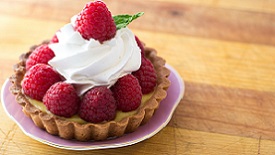
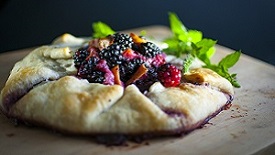

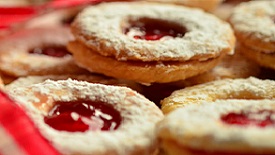
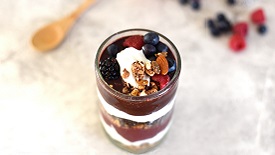
The variety of delicious fillings for crostate assures you will find something you love. Some recipes call for filling the dough after baking, while others pour the filling into the dough and then bake. There are the whole range of fillings that you will find in online recipe pages. A traditional fresh fruit filling places the fruits on a base of pasty cream (pasticceria crema). Store-bought or homemade Jams (marmellati) abound. Cookies can be filled with the same jams, or dipped, filled or covered with chocolate or an Italian favorite – Nutella. Crumbled pasta frolla make a great layer in cream or fruit-based parfaits.
Pasta Frolla Recipe
Pasta Frolla
Authentic Italian pasty dough used in a variety of recipes
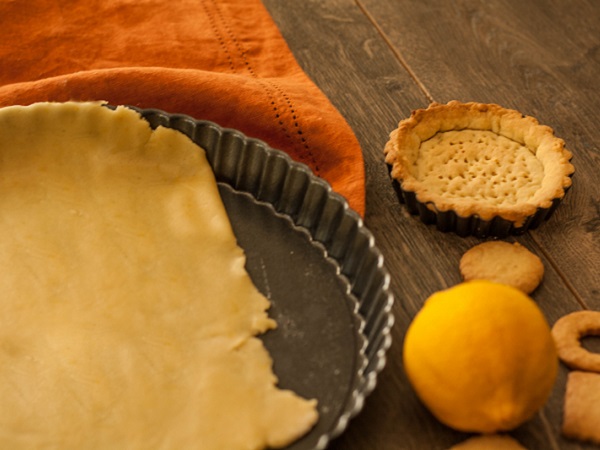
Ingredients
- 11 oz (300 g) of 00 flour (can substitute all-purpose)
- 6 oz (150 g) of high quality butter, cold
- 2 egg yolks + 1 whole egg
- 1 lemon with peel grated (organic preferred), pinch of salt
- 6 oz 6 oz (150 g) granulated sugar or 9 oz (260g) powdered sugar
- 1/8 tsp Baking soda
Directions
- Step 1 Pour the granulated sugar into the food processor, pulse 6 – 8 times, until there are fine granules but not powdered. (This step is not necessary if you are using superfine or caster sugar, or powdered sugar: see distinction below.) This will make the granules closer in size to “caster” sugar.
- Step 2 Pour the sugar from the food processor into a bowl, add cold egg yolks and whole egg, and whisk until mixture is frothy.
- Step 3 Place flour, and cold butter slices, salt, lemon zest and baking soda in a food processor, pulse 6 – 8 times. Do not over process. The mixture should have the consistency of wet sand
- Step 4 Pour in eggs and sugar mixture and pulse for another 6 – 8 pulses, or until dough begins to form a ball and starts to pull away from sides.
- Step 5 Dump dough onto rolling surface. Gently fold and press until there is a smooth dough ball, do not over knead. Now you have raw pasta frolla.
- Step 6 Tightly wrap the pasta frolla ball in cling wrap, and place in refrigerator for a minimum of 30 minutes, an hour is better or even overnight.
- Step 7 Remove the pasta frolla from the fridge, place on a wax paper or a rolling mat, and roll out to desired thickness
- Step 8 1/8th inch for pies or tarts, and your desired thickness for cookies (biscotti).
- Step 9 Slip your hand under the wax paper and gently transfer the pasta frolla to a pie pan or tart pan. When making a crostata with the edge formed from folded over dough, simply place the pasta frolla on a baking sheet. If the dough sticks to the wax paper, gently pull away with a scraper. If there are tears they are easily repaired. Trim the excess from the tart pan.
- Step 10 Puncture the bottom of the pasta frolla with a fork.
- Step 11 If you are using a filling that will bake with the pasta frolla, add it now and follow recipe directions for baking temperature and time.
- Step 12 If you are baking the pasta frolla to fill later, first place a piece of parchment paper that has been cut to fit the parchment pan. Add a single layer of dried beans to cover the the dough in the pan. This helps prevent the pasta frolla from cracking and shrinking.
- Step 13 For a shell without filling, bake at 350° F (180° C) for about 15 minutes. Remove shell from oven, and reset temperature for 325° F (170° C). Remove parchment paper and the beans. Place back in oven for another 10 minutes or until golden brown. Before filling, completely cool the shell.
- Step 14 For a small tart shell, follow the same procedure, except you will not need to fill the bottom with dried beans. Set aside and prepare the fillings
- Step 15 If you are making cookies, cut out the cookies in the desired shape after you have rolled to the pasta frolla to your preferred height. Place parchment paper on cookies sheet and bake for 10 – 15 minutes until golden brown.
What are the Keys to Pasta Frolla Success?
In a nut shell — reduce gluten concentration!
The degree of the dough’s chewiness and toughness relates to the elasticity created by gluten-based linking bonds. Gluten holds the dough together, the more gluten, the more the more elasticity and less lightness and flakiness.
The difference in the texture between bread and cake is primarily determined by the lesser amount of gluten in cake. For pastry dough, we want light and flaky which = less gluten.
Gluten in flour is released by water and heat.
Egg whites are approximately 90% water, while yolks have approximately 50% water. So, you will see most pasta frolla recipes call for either egg yolks or a combination of whole eggs and yolks. Reducing water content reduces gluten elasticity.
Pasta frolla recipes call for working with cold ingredients to reduce heating the mixture. Some online suggestions from Italian recipe sites even suggest you run your hands under cold water to keep from passing too much heat when mixing by hand.
They also call for pressing or mashing the dough together with your finger tips (not your hands), if mixing by hand, or minimal pulsing with a food processor until a dough ball starts to form.
Only minimal kneading (more like folding and press rather than stretching as with pasta dough) is also recommended, since the more the dough is worked (kneaded or mixed), the more elasticity in the gluten strands.
Various recipes call for adding the ingredients in different orders, but in general, the idea is to hold off on the eggs to ensure their water content has minimal time to activate the gluten.
If mixing by hand, stir ingredients together and combine with finger tips. If using a food processor, do not over process
Key #1: Use cold ingredients (butter and eggs right from the fridge).
Key #2: Minimal mixing to combine ingredients so they just hold together, then folding and pressing to form a smooth dough ball rather than vigorous kneading).
Key #3: Use egg yolks.
Pasta Frolla Ingredients
Flour
There are a variety of flours, each with different gluten content (all purpose, cake, pasty, 00).
Most of the recipes from Italian websites use “00” flour, but mention all-purpose flour as a substitute. The actual gluten content is very similar, but 00 flour is more finely ground and results in a smoother texture.
Sugar
Both granulated and powdered sugar (same as confectioner’s sugar, simply a different name) regularly appear in pasta frolla recipes.
Italians, when referring to granulated sugar, use what the British call “caster”, which is labeled as super fine in the U.S. (although it is quite expensive).
You can make your own Caster sugar by pulsing granulated sugar in a food processor, as long as it is not processed into powder – smaller granules should remain.
Granulated (or Caster) sugar adds a bit more crunch to the texture, powdered sugar a bit more soft-chewiness. They work equally well, it depends on the texture you desire you desire. You decide.
If you wish to substitute, and the recipe does not provide the conversion amount: 1 cup granulated = 1 ¾ cups powdered.
Baking Soda
You will frequently see “lievito” on Italian recipe websites for pasta frolla recipes. Although it is usually translated as “yeast,” most Italian recipes are really calling for a pinch of bicarbonate, which is baking soda. Often, U.S. recipe websites will call for baking powder. I prefer to stick with baking soda.
You can purchase a common brand of lievto that is extensively used in Italy — Lievito Pane Deli Angeli. With the typical Italian flair, this translates as “the yeast bread of angels.” It is actually baking soda with vanilla flavoring.
Proportions
If you are looking through pasta frolla recipes for the first time, it can be quite frustrating: the ingredients tend to be the same, but the proportions vary significantly.
As with all authentic Italian cooking, the amount of ingredients is primarily based on both the taste that you like and the “feel” of what you are working with, and the recipe’s regional origin.
For example, one recommended range for the proportion of butter to flour is 30% to 70% based how light and flaky you like the crust, more butter equals lighter. And so too with sugar, the finer the sugar the lighter and crispier.
The ratio of sugar to the amount of flour ranges from 30% to 60% in various recipes. More sugar means crispier crusts. Crostata baked with fillings call for crispier dough so they do not become too soggy during baking.
All recipes call for flour, butter, sugar, eggs, and lemon zest. A choice needs to be made on the type of flour (all purpose or 00), sugar (granulated, powdered or caster—very expensive in U.S., so lightly ground granulated sugar done at home will do), eggs (whole, yolks or combination of both), leavening agent (yeast, baking soda or baking powder).
Its really all about your personal preferences. Since pasta frolla is such a key part of so many Italian desserts, it is well worth experimenting, following general guidelines relating to degree of soft chewiness vs flaky crumbliness.
Storing Pasta Frolla
The raw dough ball, tightly wrapped in cling wrap can be left in the refrigerator for several days. Raw shells may be frozen for up to a month or more if wrapped tightly. Baked crostate or torte shells can be left at room temperature for several days.
